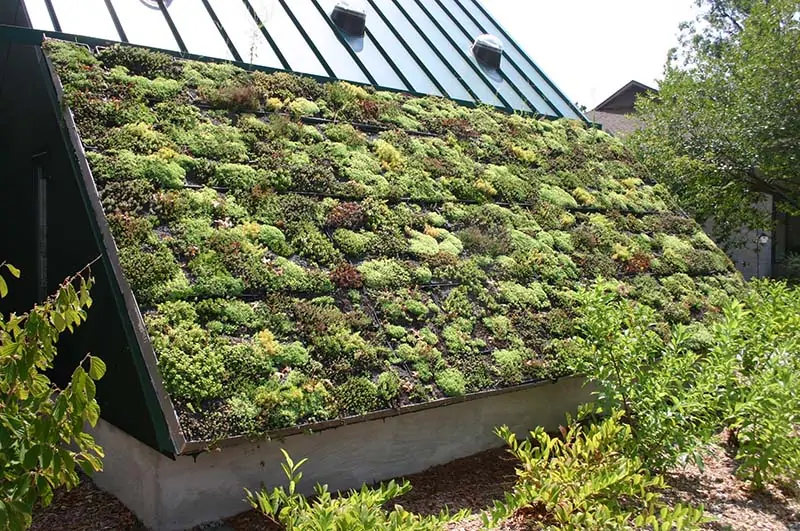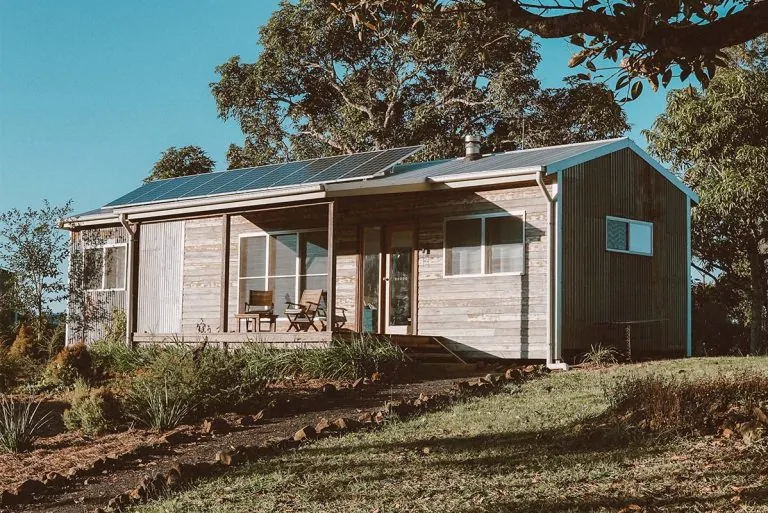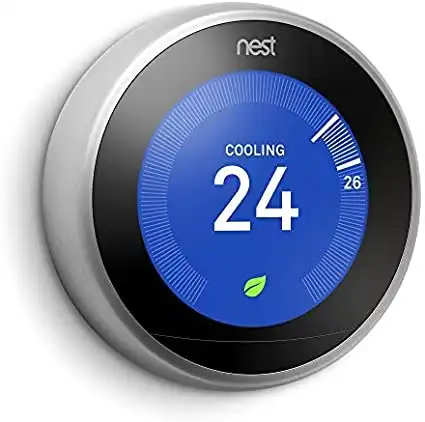When it comes to a new build, there are many things you can do to minimize the impact on the environment, from the construction to actually living in your new home. It’s crucial to do your research and get these decisions right in the planning stages, as many things can be expensive, not to mention wasteful, to change later.
Read on for 16 sustainable house design tips to make your home as eco-friendly as possible.
Tips for designing your own sustainable home
Sustainable homes may be sustainable in the way they’re built, from the building materials used to the building techniques, or eco-friendly to live in – or preferably both!
We’ll look at different ideas, tips, and inspiration for designing a sustainable home. These tips can be used when building a house from scratch, and some can be incorporated into an existing home to make it more eco-friendly, helping you to reduce your energy bills while being kinder to the planet.
1. Choose your location wisely
When it comes to sustainable house design, the first thing you’ll need to do is choose the right location.
A few location factors can influence how eco-friendly your home and/or your lifestyle will be:
- Proximity to infrastructure: Installing new infrastructure and utilities systems will inevitably have a huge impact on the local environment, so try to look for a site that takes advantage of existing infrastructure, unless you’re planning to go off-grid.
- Proximity to transportation: Sustainable house design has wider considerations than the house itself. For example, living close to public transport can help you to pursue a much more eco-friendly lifestyle compared to driving your car everywhere. So consider how close your potential new home is to public transport routes, and look for a site within walking distance if possible. Walkscore is a great resource to check how walkable your new neighborhood is.
- Vulnerability to natural disasters – Many regions are prone to natural disasters of one kind or another, so it’s not always possible to avoid this. However, if you build your house in an area vulnerable to flooding, earthquakes, or hurricanes, for example, make sure it is built to withstand such disasters so that it is sustainable over the long term.
2. Incorporate recycled materials into your design
Building materials can be harmful to the environment in a variety of ways, from the air, water, and land pollution they generate in production to the energy required to create them. When it comes to sustainable house design, It’s important to consider the embodied energy – the total impact of all greenhouse gas emissions created by a given material throughout its entire lifecycle – of solar panels.
Using recycled materials not only avoids many of these issues, but it also stops these items from ending up in landfill. There are a large range of such building materials available these days, from those which were originally used for the same purpose, such as recycled tiles, to materials that have been completely repurposed, such as composite decking made from recycled plastic.

Source: Flickr / keeping it real
Some of the fantastic recycled building materials you’ll find to aid you with your sustainable house design and building project are:
- Recycled glass countertops
- Doors, floors, and other elements made from wood reclaimed from demolished or remodeled buildings
- Bricks and masonry that has also been reclaimed from old buildings
- Roof shingles made from recycled car tires
- Landscaping soil from excavations
If you cannot find recycled materials, try to go for those that are recyclable, to minimize their long-term impact on the environment.
3. Use locally sourced building materials
Another way to keep your building materials eco-friendly is to source them locally as much as possible. Transporting local materials will generate fewer emissions compared to supplies that need to come from across the country or even across the world.
For example, in the Pacific Northwest, hardwoods such as Douglas fir, red alder and western juniper are readily available and make excellent building materials.

Source: Flickr / Jeremy Levine
This may mean adapting your design to take advantage of the amazing materials available in your area. You may need to rethink the kind of house you want, but this will give your new home an authentic, local vibe!
You may even decide to build your home in a certain location based on the local building materials that are available.
4. Consider an energy-efficient layout
When drafting your sustainable house design blueprint, taking energy efficiency into account can make a huge difference to the building’s impact on the environment. Any structure with a large surface area is less energy-efficient, as the increased surface allows more heat to escape.
Therefore, a taller and more compact house is generally more energy-efficient than a low and wide structure with the same number of square feet. Similarly, cubes and spheres are more efficient than more irregular, spread out shapes.

Furthermore, how you orientate your house is also a key component of sustainable house design. Where you put your windows, in particular, can help you take advantage of natural light and heat. In the Northern Hemisphere, south-facing windows will give you more sunlight in winter, allowing you to minimize your reliance on artificial heating and lighting.
On the other hand, too many west-facing windows will provide more light and heat on sweltering summer afternoons and encourage you to use your air conditioning more. Similarly, roof overhang will block the sun in summer, keeping your home cooler for longer.
However, don’t worry about your roof obstructing precious winter sunlight! Because the sun is lower in winter than it is in summer, the right amount of roof overhang will block harsh rays in summer while letting the light in during winter.
Your landscaping can also make your home more energy-efficient. Plant a deciduous tree in front of south facing windows to provide shade in summer but let light through in winter.
For even more tips, check our separate post on how to build an energy-efficient home on a budget.
5. Use low energy consumption appliances
An eco-friendly home goes far beyond the design, location, and building materials you use – you also need to consider the appliances you use. Sustainable house design is also about filling your home with appliances that consume lower energy is not only better for the environment, but it will also greatly reduce your energy bills, or let you run your home on renewable energy.
Manufacturers are now offering low energy consumption appliances in just about any niche you can think of, from washing machines to kitchen appliances. At a minimum, look for Energy Star rated appliances – this should cover everything from computers and TVs to kitchen appliances and water heaters.

LED lighting is also much more energy efficient, and lasts much longer. Even though it requires a larger upfront investment, this pays itself off over time because you won’t need to change your LED light bulbs for years!
6. Incorporate smart home technology
Along with low energy consumption appliances, using smart home technology can also help to make your home more eco-friendly. Smart home systems have features such as automated lighting, temperature, and security controls which allow you to make your energy use as efficient as possible.
Most smart home systems also allow you to monitor the amount of energy you use, helping you to live more efficiently and use less electricity.
7. Opt for energy-efficient HVAC
While energy-efficient appliances can make a difference, your heating and cooling is even more important, as this is where most homes’ energy consumption comes from. Therefore, energy-efficient HVAC (heat ventilation air conditioning) is a key part of sustainable house design.
This should start with the design of the building and the heating and cooling systems. For example, breaking your home into zones which can be heated or cooled when you’re using them means you’ll use much less energy than trying to control the temperature of the entire home.
In particular, you should separate out areas that do not need to be heated or cooled because they’re not often used, such as the basement or laundry.
8. Consider geothermal heating
One fantastic example of sustainable heating is geothermal heating, sometimes also called geoexchange, earth-coupled, or earth energy systems. Residential geothermal heating systems take advantage of the sun’s radiant energy that has been absorbed by and stored in the ground near your house.
In this way, geothermal heating is an indirect form of solar energy, which is available any time of day or night!

Source: Wikimedia / WGisol
There are a few different types of geothermal heating, but all use a buried or submerged “loop field”, typically made of polyethylene tubing. There are both open and closed-loop systems, but these essentially work in the same way by bringing the heat energy stored in the soil or groundwater to your home via these tubes.
9. Opt for eco-friendly insulation
Good insulation is essential for sustainable house design, and planning for an eco-friendly home, as it plays a big part in keeping the building energy efficient. A well-insulated building doesn’t need as much heating and cooling, so uses much less energy.
However, insulation has traditionally been made from hazardous, toxic materials which have a range of negative impacts on the environment.

If you want your home to be truly environmentally-friendly, it is important to make sure that it is not only well-insulated, but with eco-friendly insulation. Take a look at our wrap up of the different types of eco-friendly insulation for more.
10. Harness the sun and the rain
To maximize the energy efficiency of your sustainable house design, it’s important to consider not only how much energy you use, but also where that energy comes from. Therefore, being more energy-efficient while relying on renewable energy is a win-win for sustainability!
One of the most popular (and best) ways to power your home with renewable energy is using solar panels. It is relatively easy to install a solar system in your home to give you free, eco-friendly energy, while adding value to your home.
For more on the best solar panels for residential properties, check out this guide.
You can also harness the natural water resources through rainwater harvesting. There are various methods you can use to collect and store rainwater for your bathroom, laundry, or even for drinking.

Source: Wikimedia / SuSanA Secretariat
This not only allows you to make better use of this precious resource, but properly-harvested rainwater is also pure and chemical-free, and so better for your health. For instance, water collection is an essential part of an Earthship home.
You can read more about the pros and cons of rainwater harvesting in our detailed guide.
11. Consider living walls or roofs
Sustainable house design involves a certain amount of ‘outside the box’ thinking, and incorporating a living roof or wall into your plan is an example of just that.
A living roof is topped with a water-retaining layer that supports living grasses, flowers, or even shrubs. This creates a highly energy-efficient and eco-friendly surface that naturally insulates your home, not to mention that it looks stunning!

Likewise, incorporating living walls into your home can make the building more energy-efficient, not to mention aesthetically pleasing. Not only this, but studies have shown that plants improve air quality by filtering toxins from the air.
12. Try an eco-friendly lawn alternative
Grass may be a popular lawn option, but it is also water-intensive, difficult to maintain, and can cause allergies. There are plenty of grass alternatives that are not only better for the environment and your health, but many need little to no maintenance.

Eco-friendly lawn alternatives include:
- Moss beds
- Sedum plants
- Ground covers like creeping thyme, Corsican mint, chamomile, and soleirolia soleirolii
- Eco-lawn (a mix of grass seeds and ground covers like micro leaf clover and moss)
- Wood chippings or bark
- Gravel
Alternatively, you can simply let your lawn lie fallow and let native plants and flowers take over, creating your own mini wildflower meadow.
13. Consider prefab homes
Sustainable house design is a concept that already exists tobe rolled out to the masses – in the form of prefabricated, or ‘prefab’, homes.
A prefab home is partially constructed in a factory, and then these component parts are put together onsite, where the dwelling is to be permanently.

Certain characteristics of these types of constructions make them better for the natural environment than many other types of builds:
- Efficient in construction – Because these homes are pre-built on a large scale in a factory, they are usually more precise in their use of materials and generate less waste.
- Efficient transportation – Additionally, all the parts are transported and delivered at the same time, minimizing the cost and environmental impacts of transportation.
- Durable – Contrary to what you may think, prefab homes can actually be more durable than traditional builds, because materials are reinforced for transport. This means they last longer and minimizes the negative impacts of repairs and upgrades on the environment.
Of course, not all prefab homes are as kind to the environment as others – check out our guide to the best eco-friendly prefab homes. These prefabs are made from sustainable materials and partially built offsite using environmentally-sound practices, and may also incorporate eco-insulation.
14. Consider the best size for a sustainable home
Sustainable house design means applying careful consideration to size and space. The size of your house has two main implications for the environment:
- A larger home will take more energy to heat, cool, and power in general
- A larger construction requires more materials and energy to build in the first place
Therefore, the smaller the house you build, the more efficient and less wasteful it will inherently be. It may not be practical or desirable for everyone to live in a super small house, but the more you can keep the size of your new home down, the more eco-friendly your house is likely to be.
You can even take this to the extreme with a tiny home, which we’ll talk about in the next point!
15. Consider a tiny home
The tiny home trend has surged in popularity in recent years, and it’s not hard to see why. These houses have an average size of 186 square feet and are extremely efficient, eco-friendly, and cost-effective.
Consider their carbon footprint for example:
- An averaged-sized US home of around 2600 square feet would produce around 28,000 pounds of CO2 per year through heating, cooling, and energy use if run on non-renewable energy.
- The electricity required to heat, cool, and power a tiny home would only generate around 2,000 pounds of CO2 if produced by a coal power plant.
(You can calculate your own home’s greenhouse gas emissions using the EPA’s carbon footprint calculator.)

Source: Wikimedia / Albert13377
An Australian study confirmed that tiny homes can reduce an individual’s personal carbon emissions by 70% over their lifetime.
This is because such a small space is very efficient to heat or cool, and these homes typically use smaller and more efficient appliances. Furthermore, because of the low energy requirements, it is very easy to power an entire tiny house on a solar system, so your tiny home may not generate any greenhouse emissions at all!
Beyond the energy efficiency and low emissions, tiny homes also require far fewer (potentially environmentally-hazardous) building materials and are portable. So if you want to move you can simply take your home with you instead of having to build again!
16. Go Electric
All-electric homes can also be very eco-friendly, depending on where your energy comes from. A study by the Rocky Mountain Institute showed that not only are all-electric houses more economical than mixed-fuel homes, but they also have significantly fewer greenhouse gas emissions.
The study found that homeowners in Seattle reduced their carbon emissions by 93% by making their house all-electric, while those in many states experienced reductions of more than 50%. Of course, this is only possible if you get your electricity from renewable sources, such as your own solar system or an energy provider who runs on renewables.
How to build a sustainable house
Sustainable house design starts from where you decide to build your home and the layout you choose, to how you power it and the insulation.
There are many ways you can make your home more eco-friendly, ranging from smaller actions such as switching out the traditional grass lawn to the kind of house you choose to build. You may choose a sustainable tiny home or prefab house, but there are plenty of other ways to make your house more environmentally friendly.
For more inspiration on creating a sustainable home, take a look at our posts on truly green prefab homes and recycled building materials.













